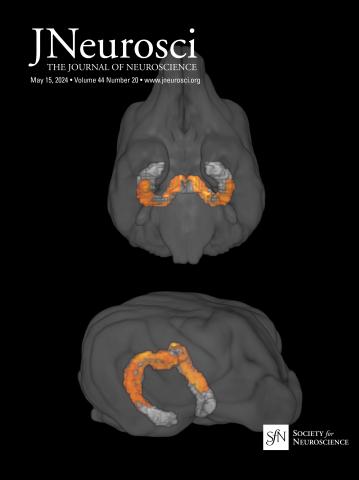Attention alters population spatial frequency tuning.
IF 4
2区 医学
Q1 NEUROSCIENCES
引用次数: 0
Abstract
Spatial frequency (SF) selectivity serves as a fundamental building block within the visual system, determining what we can and cannot see. Attention is theorized to augment the visibility of items in our environment by changing how we process SFs. However, the specific neural mechanisms underlying this effect remain unclear, particularly in humans. Here, we used functional magnetic resonance imaging (fMRI) to measure voxel-wise population SF tuning (pSFT), which allowed us to examine how attention alters the SF response profiles of neural populations in early visual cortex (V1-V3). In the scanner, participants (5 female, 3 male) were cued to covertly attend to one of two spatially competing letter streams, each defined by low or high SF content. This task promoted feature-based attention directed to a particular SF, as well as the suppression of the irrelevant stream's SF. Concurrently, we measured pSFT in a task-irrelevant hemifield to examine how the known spatial spread of feature-based attention influenced the SF tuning properties of neurons sampled within a voxel. We discovered that attention elicited attractive shifts in SF preference, towards the attended SF. This suggests that attention can profoundly influence populations of SF preference across the visual field, depending on task goals and native neural preferences.Significance Statement The spatial frequency (SF) preference of neural populations in early visual cortex governs the coarse and fine details we can see. However, the brain is limited in what it can process, requiring selective attention to prioritize relevant over irrelevant details. Although SF is fundamental to visual processing, it remains unclear how selective attention to SF alters population-level responses to SF. Using fMRI, we measured SF preferences in V1-V3 while participants deployed feature-based attention to one of two competing stimuli solely defined by their SF. We found that attention produced attractive shifts in preferences across the visual field, towards the attended SF, demonstrating that voluntary attention can flexibly reshape SF preferences in early visual cortex.注意力改变人口空间频率调谐。
空间频率选择性是视觉系统的基本组成部分,决定了我们能看到什么,不能看到什么。从理论上讲,注意力是通过改变我们处理sf的方式来增加我们环境中项目的可见性。然而,这种效应背后的具体神经机制仍不清楚,特别是在人类中。在这里,我们使用功能性磁共振成像(fMRI)来测量体素方向的群体SF调谐(pSFT),这使我们能够研究注意力如何改变早期视觉皮层(V1-V3)神经群体的SF反应谱。在扫描仪中,参与者(5名女性,3名男性)被提示秘密地参加两个空间竞争的信件流之一,每个信件流由低或高SF含量定义。这项任务促进了对特定SF的基于特征的注意,以及对无关流SF的抑制。同时,我们测量了与任务无关的半场的pSFT,以研究基于特征的注意力的已知空间分布如何影响体素内采样神经元的SF调谐特性。我们发现,注意力会引起人们对科幻小说的偏好发生吸引人的转变,倾向于被关注的科幻小说。这表明,注意力可以深刻地影响整个视野范围内的SF偏好群体,这取决于任务目标和原生神经偏好。早期视觉皮层神经群的空间频率偏好决定了我们所能看到的粗细细节。然而,大脑的处理能力是有限的,需要有选择性的注意来优先考虑相关的细节。虽然SF是视觉处理的基础,但目前尚不清楚对SF的选择性关注如何改变人群对SF的反应。使用功能磁共振成像,我们测量了V1-V3的SF偏好,当参与者将基于特征的注意力部署到两种完全由他们的SF定义的竞争刺激之一时。我们发现,注意在整个视野中产生了有吸引力的偏好转变,朝向被注意的SF,这表明自愿注意可以灵活地重塑早期视觉皮层的SF偏好。
本文章由计算机程序翻译,如有差异,请以英文原文为准。
求助全文
约1分钟内获得全文
求助全文
来源期刊

Journal of Neuroscience
医学-神经科学
CiteScore
9.30
自引率
3.80%
发文量
1164
审稿时长
12 months
期刊介绍:
JNeurosci (ISSN 0270-6474) is an official journal of the Society for Neuroscience. It is published weekly by the Society, fifty weeks a year, one volume a year. JNeurosci publishes papers on a broad range of topics of general interest to those working on the nervous system. Authors now have an Open Choice option for their published articles
 求助内容:
求助内容: 应助结果提醒方式:
应助结果提醒方式:


